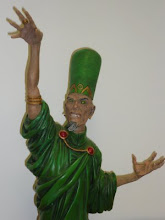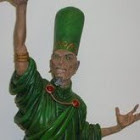 A slightly stodgy historical murder mystery that fails to engage as a Sherlock Holmes story. Sherlock Holmes is involved in the Jack the Ripper murders that took place in London in 1888.
A slightly stodgy historical murder mystery that fails to engage as a Sherlock Holmes story. Sherlock Holmes is involved in the Jack the Ripper murders that took place in London in 1888.There are two stories involved in the book and one is significantly more effectively developed and executed than the other, there is the actual historical events of the Jack the Ripper murders which is used as a framework to hang a Sherlock Holmes story on. Edward B. Hanna has clearly extensively researched the murders and uses the research very well to lay out the whole context of the murders. He establishes the scale of the shock and outrage caused by the brutal killings and the enormous fear they caused in the ruling class that they would crystallise unrest and frustration among the very have nots. The sense of a settled social order where everyone knew and accepted their place was central to social stability and the maintenance of power and privilege. The murders represented a direct challenge to this as they stirred the destitute in unpredictable ways, ways that could possibly be harnessed by those with agendas directly opposed to those of the current rulers.
That story is well told, the range of characters is developed and the responses revealed as they scrambled to counter the multiple threats that arose from the killings. At times the research and explanation weight a little too heavily, for much the greater part they are well done and informative.
The significant problem is that this is supposed to be a Sherlock Holmes' story in which case history is a set to serve fiction requirements rather than as happens here, the reverse. Sherlock Holmes is trapped in the requirement to be historically accurate and as a result cannot be Sherlock Holmes.
Edward. B. Hanna's historical approach is used in an interesting way as he weaves the details of the original Sherlock Holmes stories into the narrative of the Jack the Ripper murders and uses the spaces available in a creative way. The extensive notes at the end that tie up historical characters and the fictional timelines and details are enjoyable.
Sherlock Holmes stories have strict and very well established requirements, the question for any writer wishing to write a Sherlock Holmes story is to either embrace them or discard them as creatively as possible. They have to be the dominating influence on the story or else it will simply not be a Sherlock Holmes story. In this case another set of requirements was allowed to dominate instead and in spite of a strong effort to bring in the fictional element it fails because of this.
As a matter of personal preference I strongly prefer stories where Sherlock Holmes in not a directly leading character that the narrative follows, I think he is much more suited to being seen from afar as the aloof and essentially mysterious character he is. His humanity is borrowed from Watson and this is the best way to enjoy him. Edward B. Hanna uses Holmes directly and he makes a very credible effort in doing so, I think in this case the problem was that the reader got both too much and too little of Sherlock Holmes.


No comments:
Post a Comment